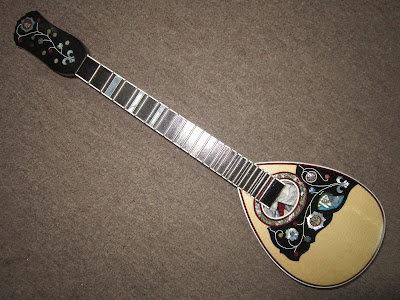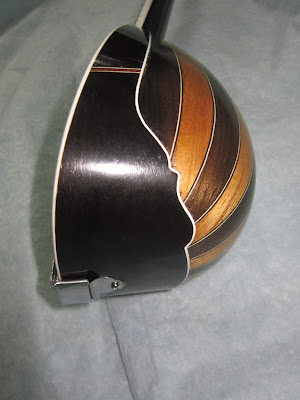The master luthier of Spartan Instruments Shop and the Karabas bouzoukia !
A low-profile instrument maker, with exceptional talent !
For the last few years , I have followed closely a master Greek luthier based in Lowell, MA USA.
His name is Chris G. Pantazelos maker of stringed instruments. He works at the Spartan Instruments shop. (spartaninstruments.com)
From time to time I have visited his website, reviewed his unique creations, followed his experimentation and intense research on musical instruments of ancient Greece, and allured by some of his unique and beautiful decorative designs and materials used on instruments of the bouzouki family.
Chris is a massive resource of information and knowledge regarding string instrument construction . I have enjoyed our one-time in-depth telephone conversation regarding pre-war bouzouki instrument construction, some years ago.
As a character, Chris is a low-profile person, who does not use "conceit and fanfaronades" to promote his work. With great passion and talent, he is working in "obscurity of the public lights", creating small masterpieces.
In one of my latest visits to his web site, the exceptional repair and restoration work he performed on a beautiful Theodoros Karabas bouzouki made me recall his talent, and became the reason to write this article . I also noticed the creation of a beautiful and unique Greek baglamas!
The luthier actual did two restorations on two similar bouzoukia by Theodoros Karabas recently.
Both were without a date but from the label we can estimate that were constructed probably between 1900 and 1920 (or a bit later).
The first bouzouki had a bowl made out of rosewood staves and maple end-clasp, spruce soundboard, mahogany neck and a dyed walnut (?) fingerboard. The top decorations were similar to both bouzoukia and appeared to be made from stock guitar wood binding and rosette decorations.
The only difference on the second bouzouki was that all of the staves were rosewood, but their appearance varied, (maybe they were leftovers from other projects e.g: guitar cutoff wood). The rosettes were a white hardwood painted in gold (boxwood?).
The scale for both was 72 cm.
The luthier had to pretty much disassembled and reassembled both. All original parts were kept but the fingerboards had deteriorated due to a caustic dye used on them. Chris made exact replicas of both out of Brazilian walnut due to the fact that Brazilian walnut is a bit harder wood in comparison to the American or European walnut.
The Karabas instruments needed reinforcement and re-bracing of the soundboard, repairing of the bowl, re-construction and re-fretting of the fret boards, and re-polishing.
I am posting some photographs of the step by step meticulous repair and restoration performed by Chris G. Pantazelos
Bowl made by dyed black walnut and mulberry wood, with double fillets between the staves, AAA grade spruce for the sound-board, ebony wood for the fret-board, poplar wood for the neck, natural sea-shell, celluloid and acrylics for the decorations.
The novelty in this baglama instrument is that the luthier used gold imitation metal line (brass) on the designs of the pick-guard and the head-stock. Also the black background on the pick-guard and head stock is not plastic material as commonly used by luthiers, but a phenolic resin composite that has properties a bit closer to wood. The luthier learned about this material from the master luthier Peter Kyvelos who liked it as a fingerboard substitute for ebony.

















































Υπέροχη ανάρτηση Σπύρο!!!!
ReplyDelete